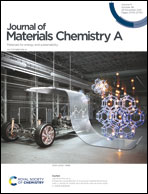Calixarene-based porous 3D polymers and copolymers with high capacity and binding energy for CO2, CH4 and Xe capture†
Abstract
The supramolecular capacity of calixarenes towards guests is largely consolidated; in contrast, the synthesis of porous calixarene-based frameworks by covalent bond formation is still a challenge. Our target was to yield 3D polymers and copolymers based on calixarenes for selective gas-capture, endowed with easy pore accessibility and specific sites, and built via a straightforward synthetic route. The covalent calixarene frameworks (CXFs) were prepared by the Yamamoto coupling reaction starting from tetrabromo calixarene propoxy- and methoxy-monomers of three stable calixarene (partial cone, effective cone, and 1,3-alternate) conformers and complete post-synthetic deprotection to achieve polar phenolic calixarene derivatives. Moreover, the copolymer of calixarene-based monomers with tetrabromo-tetraphenylmethane exhibited remarkable surface area up to about 3000 m2 g−1. Smart architectures endowed with hierarchical porosity from micro- to meso-porosity showed notable sponge-like swellability by CO2, which was captured effectively at room temperature, even in competition with N2, yielding CO2 removal in column breakthrough experiments. Indeed, CXFs displayed excellent CO2 and CH4 energy binding of 35 and 24 kJ mol−1, respectively. Ultramicropore sites were highlighted by Xe capture and in situ detection after a xenon diffusion time of a few milliseconds, by laser-assisted hyperpolarized 129Xe NMR, revealing the accessibility of calixarene capsules and the available space. This synthetic route demonstrated the possibility to modulate at will the pore capacity and selectivity, displaying porous frameworks with two distinct pore families, wherein calixarene moieties play the role of small and selective sites. A contractile behavior of the frameworks was observed upon deprotection which produced more polar sites, due to the formation of hydrogen bond networks.



 Please wait while we load your content...
Please wait while we load your content...